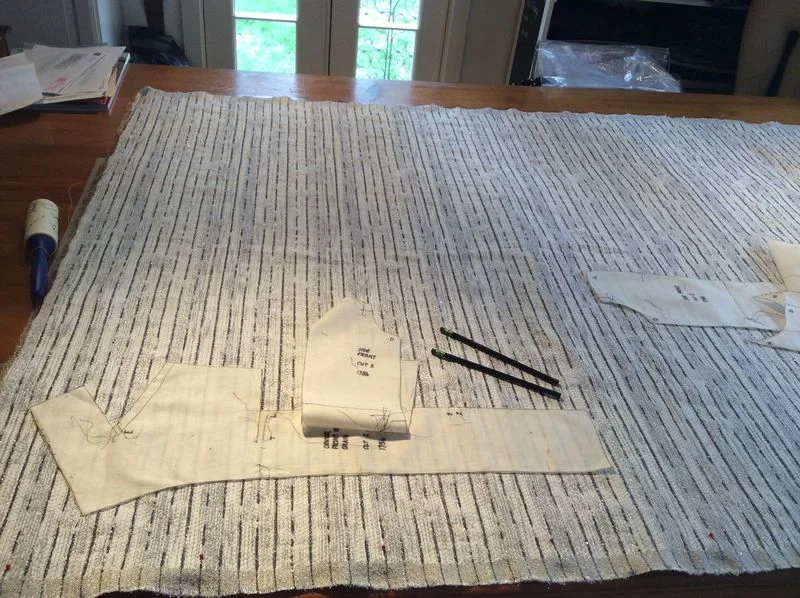Marfy sew along 1756 Pt 6 - Thread tracing
Finally after all that work, we now reach my favorite part....thread tracing.
Meditative, mindless sewing!
Thread tracing is exactly as it sounds, you use a thread to trace the outside of your pattern...as well as your notches, darts and grain lines.
Why do we thread trace?.... once your standard seam lines are removed from a muslin, you have to find a new way of transferring the sewing lines to your fashion fabric, as your pattern will soon be removed... Thread tracing becomes a perfect semi-permanent solution. (These stitches will remain in your garment until its completion)
I like to use one colour initially to baste the muslin line and then as I alter or adjust a sew line after fittings etc I use different colours, so that I can easily remark my pattern and make a record of what I have done.
Of course, if you have chosen to sew with a seam allowance and have underlined, then you get to use your sewing machine.
To do this ...set your machine to the largest stitch length and slowly work your way around each pattern piece joining your underlining in place smoothly and neatly, keeping your stitch line at about a 1/4" to 1/2" close to the raw edge...so that it will remain hidden once construction is complete.
I've borrowed some info and images below from the LFJ sew along....
THREAD TRACING
There is only one really important rule with thread tracing and this is that your garment piece must remain flat.... no holding it in the air like you are ready to darn! your grain is not stable enough at present to be moved around and stretched out.
So, how do you thread trace?
To begin, you will choose a thread in a deeply contrasting colour to your fabric, so that all marking's can be seen quickly and clearly.
Silk thread is beautiful for thread tracing, it can be a little harder to find than cotton or polyester but there are still stores that sell it.
Jo-Annes in the US has a small stock, as well as some of the more specialized fabric stores...and if you search Ebay and similar you might be lucky enough to find some Belding Corticelli, its the gold standard of silks....and although what you will find will be decades old, it normally remains as strong and viable as the day it was spun.
Lately though, I have become very partial to Japanese basting thread, its actually a cotton that feels very smooth and silky..... there are a couple of places in the US that sell it including Shibori Dragon and at $3.50 a skein for 450 yards it lasts a long long time!
Click here for more suppliers..
I've used this on many different fabrics and it continues to glide out of all of them with a slight tug when the garment is complete....no pulling of fashion fabric threads or knotting... its gorgeous stuff.
but, of course, if its to hard to find or you don't think you will use it again, a double strand of cotton will do the trick....just snip it out rather than pull when your garment is complete.
So why is silk better? ..well simply.. a cotton spooled thread is made up of lots of little threads woven together to make one strong thread, so that it "grabs" the fabric and holds still... it has a rougher texture and is very stong, a silk thread is usually a single strand which gives it the ability to glide through fabrics. Its not strong enough to join garments together for any length of time and will disintegrate far quicker than a cotton in a seam but for thread tracing, it is simply perfect.
To begin...start by leaving at least 1" of tail and then sew a running stitch up the entire length of one edge...
Try to keep each line separate with a tail at the top and bottom. It makes removing it easier, as you won't have to try and pull thread from around corners. A simple pull and the whole strand should just come away.
and as these stitches are just guides for construction, they don't need to be too neat or too small...
and remember to thread trace your grain lines....I usually mark with pins on the right side and then draw a pencil guide on the underside before thread basting.... I know its a extra stage but once you get used to looking for these when you fit they will change the way you think, pulling a grain offline can cause so many wearing issues that its a great habit to get into!
Transferring darts, notations etc
There are two ways to do this, either by using your carbon paper to mark the wrong side..
or by using pins to mark the legs and points, notches and grain lines...before using a pencil on the wrong side to draw the info onto the underlining........and then thread tracing.
To finish, make sure that every mark, notch and grain line has been added and then remove your pattern piece and pins :-)
Tomorrow we will be making a pattern and cutting our back and side stays.
Any questions? Hellochallengingsew @gmail.com (envelope icon at top right) or leave a comment :-)




